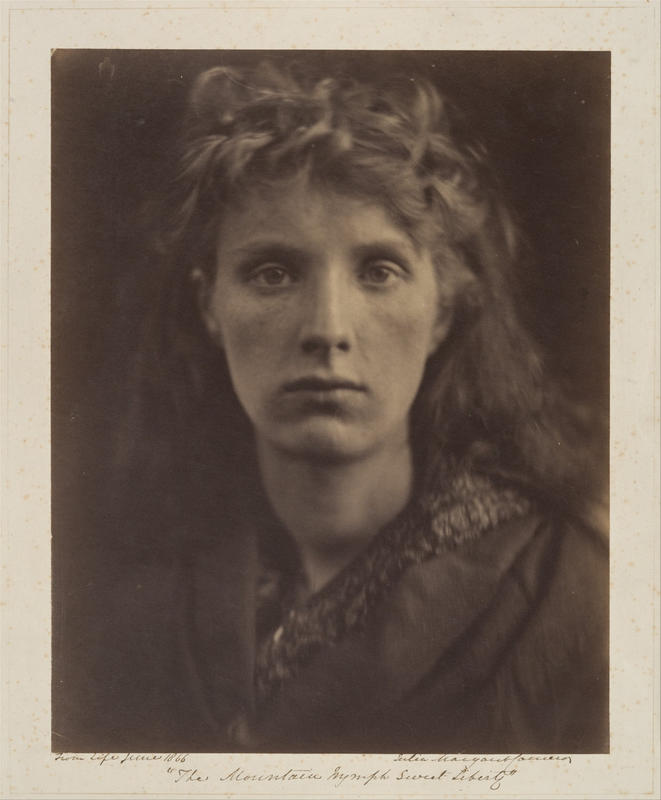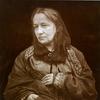More about Mountain Nymph, Sweet Liberty

Contributor
This work by Julia Margaret Cameron is a little different than the rest.
Considering she was known for shooting photos of her friends--a parlor maid as the Madonna, her husband as Merlin, her husband again as King Lear, a neighbor’s child as the infant Christ, just to name a few--it’s interesting that the subject of this photograph is simply Mrs. Keane, a person of unknown relation to Cameron and not a hired model, either. Based on the fact that Cameron routinely hung out with the likes of Lord Tennyson, Thomas Carlyle, Sir John Herschel, Henry Taylor, and G.F. Watts, one can only wonder how cool a person this Mrs. Keane must have been to make the cut.
Though we don’t know anything about the sitter, we know quite a bit about the portrait itself. An inscription on the back of this, as well as on the backs of the eight others in the series (all with the same title and very similar style), quotes from the poem "L'Allegro," written by John Milton. In Milton’s poem, he begs the Goddess of Mirth to grant him true happiness, which he describes mostly as nature though also as a Nymph of Liberty (depicted here).
Throughout her career, Cameron loved to take existing poems and reinterpret the roles of the women in them, bringing them to life in a powerful way through her photography. This strategy has been a recent trend in literature, the retelling of the stories of mythological women in a way that gives them more agency and sense of character.
Interestingly, all the versions of this portrait bear inscriptions quoting Milton, but only one also quotes her friend and legendary poet, Tennyson. The poem it references, "Lady Clara Vere de Vere," is an autobiographical poem that comes from Tennyson's personal experience of a lady refusing his love because of his lower social class. This serious-looking portrait wasn’t just attempting to depict someone “celebrating life’s pleasures” as Milton’s poem implies. Instead, she depicts a woman refusing a man’s love. In Milton’s poem, the woman is the Goddess of Mirth refusing Milton and, in Tennyson, it’s even more direct, she’s the lover who wants nothing to do with him.
The photo was also interesting because in terms of Cameron’s career, it represented a movement to a bigger camera and albumen prints, which require the use of egg whites to get their coloring. She sent this photo to a famous scientist, Sir John Herschel, who described it by saying, “She is absolutely alive and thrusting out her head from the paper into the air. This is your own special style."
Sources
- Anonymous. "The Mountain Nymph Sweet Liberty: Cameron, Julia Margaret." V&A Search the Collections. Accessed July 31, 2019. https://collections.vam.ac.uk/item/O191694/the-mountain-nymph-sweet-lib….
- Dotson, Keith. "'The Mountain Nymph, Sweet Liberty (Ms. Keene)' a Photograph by Julia Margaret Cameron" Keith Dotson | Catching Shadows. August 14, 2018. Accessed July 31, 2019.https://icatchshadows.com/mountain-nymph-sweet-liberty-ms-keene-photogr…
- “Julia Margaret Cameron (1815–1879)” Metmuseum.org. Accessed July 12, 2019. https://www.metmuseum.org/toah/hd/camr/hd_camr.htm..
- Lane, Anthony, and Anthony Lane. "Names And Faces." The New Yorker. July 09, 2019. Accessed July 12, 2019. https://www.newyorker.com/magazine/2013/09/02/names-and-faces?reload=tr….
- Rosenberg, Karen. "Ardent Victorian at the Lens." The New York Times. August 22, 2013. Accessed July 31, 2019. https://www.nytimes.com/2013/08/23/arts/design/julia-margaret-cameron-a….
- Wolf, Sylvia. Julia Margaret Cameron's Women. Art Institute of Chicago; Yale University Press.











